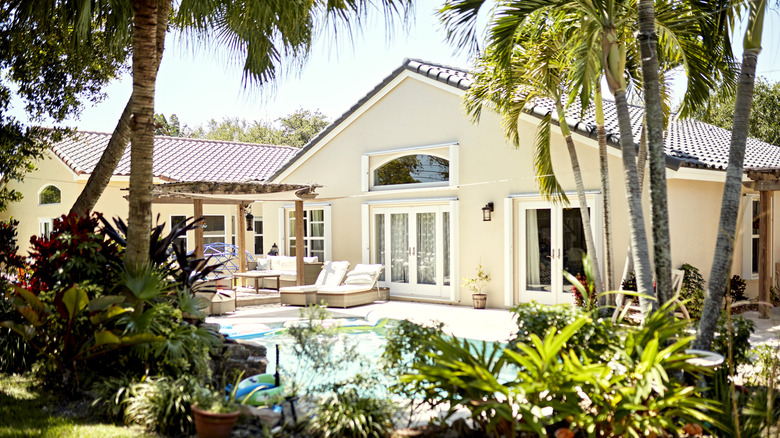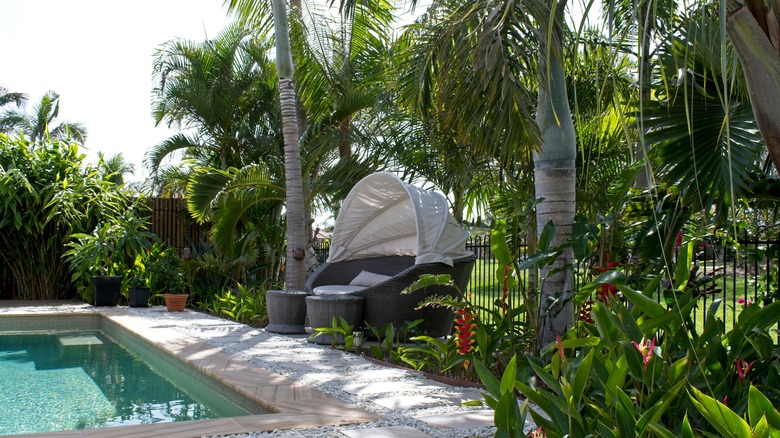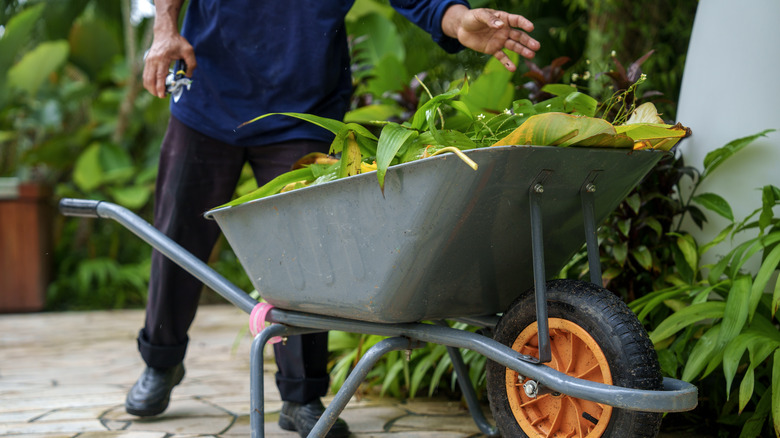The Tropical Palm Tree You Should Plant For Shade And Bright Purple Flowers
If you're thinking of turning your backyard into a personal tropical paradise, king palms (Archontophoenix alexandrae) will give you that much needed island flavor you're looking for. Native to the rainforests of Queensland, Australia, and popular in cities like California and Miami, these trees are favorites among gardeners and homeowners who love them for their tall and breathtaking aesthetic. Their dramatic and glossy fronds fan out to provide cool and peaceful shade alongside delightful bright, purple blooms that pour down their tall trunks, adding to their island vacation appeal.
These towering palms thrive in partial shade to full sun where they can grow to become 50-80 feet in their native habitat or 30-50 feet tall in urban environments with a lifespan of 25-50 years. It's in these cities and suburbs where they are truly favored over other palm varieties because of how low maintenance they are as well as how these trees can survive in extremely windy environments. Besides gracing your gardens, king palms are often planted in city streets, in gardens, or near pool areas.
Benefits of planting king palms in your backyard
Beyond the gorgeous aesthetic they bring to your backyard, king palms are a great choice for your tropical garden because of their fast-growing nature. The tall, smooth trunk can grow up to 24 inches per year, meaning you could see your backyard transforming into the lush paradise you've always dreamed of. Their dense, evergreen foliage produces delightful purple flowers that can attract pollinators to your garden. These blooms go on to bear fruit that birds keep coming back to enjoy. Planted in a row near a fence or as a cluster around the pool, these palms are a good option if you're looking for fast-growing trees that can act as a privacy screen. Their foliage can also prove useful as a wind break.
Birds are particularly fond of king palms because their tall and smooth tree trunks provide them with safe nesting far from where ground predators can reach their young. The king palm's harmonious bountiful benefits don't stop there, however. These trees also work great in urban areas because of how well they absorb noise and air pollution. Like other trees, king palms filter out pollutants in the air and release oxygen, but they do that exceptionally well in densely populated urban areas. They are also useful in preventing soil erosion which can become problematic in areas like California. Their deep root system helps to stabilize the soil and strengthen the underground environment.
Important things to know before planting king palms
Just because king palms do well in warm and humid climates, doesn't mean they're not susceptible to their fair share of pests and diseases. King palms are known to attract spider mites and scale insects. They are also said to be vulnerable to fungal diseases like leaf spot and root rot, so staying ahead of such pest and disease infestations is important to ensure the health and longevity of your palm trees. Keep a close eye on your young palms, watching for yellowing and sticky residue around the fronds.
Staying ahead of pests and diseases won't only help to protect the biodiversity in your backyard, but it will also help you keep your backyard looking its best. King palms need well-drained soil with regular watering, ensuring that your palm trees can maintain moisture, and good temperatures will help them the most during dry seasons. You can do this by mulching around the base of each tree. Pruning is also a good idea after the blooming season. Start by removing damaged or dead fronds and flower stalks. This will help your trees look even better without wasting valuable resources on dead ends. Be careful not to excessively prune your palms as this can stress the tree out and negatively affect its growth. A good palm fertilizer can also help you fight mineral deficiencies in your garden and keep it looking green and vibrant.



